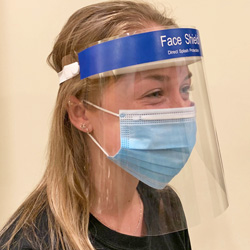
Check out Safety Emporium for your N95, N99, and face shield needs.
(Note: This post is 8 years old and may contain outdated information.)
From: ILPI Support <info**At_Symbol_Here**ILPI.COM>
Subject: Re: [DCHAS-L] Grassroots lab safety examples?
Date: Tue, 10 Oct 2017 16:13:27 -0400
Reply-To: ACS Division of Chemical Health and Safety <DCHAS-L**At_Symbol_Here**PRINCETON.EDU>
Message-ID: 0FB0975E-C0C9-4256-B898-EE0EF1AA421F**At_Symbol_Here**ilpi.com
In-Reply-To <7CF7175D-5665-48F8-BDDC-2DE2ACC00633**At_Symbol_Here**keene.edu>
1. During my grad work at MIT the project I took over relied on arylisocyanates to make transition metal imido complexes. We made the isocyanates ourselves using phosgene on a rather large (100g +) scale. I found that some of these were commercially available for $2 per gram which, while significantly more expensive than the corresponding anilines and phosgene, let us bypass the hazards involved and saved time so we could get to working with our materials. So while on the surface purchasing the material was more expensive, it was actually more economical from an efficiency and life cycle approach. After scouring the literature, I later streamlined the synthesis to eliminate the need for isocyanates completely and we were able to use the corresponding alkyl and aryl amines to make our starting materials in a high yield one pot synthesis. You see this kind of evolution quite a bit in the catalysis field - someone finds a nice catalyst through a lot of hard work and funky reagents and then refines the synthesis to be more elegant and greener.
2. Organometallic chemists quickly picked up on the advantages of using columns to purify their solvents instead of maintaining 5 liter stills full of sodium/benzophenone ketyl or Na/K alloy.
3. Fluorination chemistry has moved away from elemental fluorine or nasty compounds with O-F bond to those using N-F bonds.
4. Migration away from mercury-filled thermometers as well as bubblers and manometers. A lot of that I think came in research labs without prompting given the joy of cleaning up mercury spills.
5. Hydrogenations have come a long way - reactions that used to require high pressure bombs (and an actual bomb room with blow-away roof) can be done with all kinds of milder reagents these days.
Rob Toreki
======================================================
Safety Emporium - Lab & Safety Supplies featuring brand names
Fax: (856) 553-6154, PO Box 1003, Blackwood, NJ 08012
In a conversation with a colleague today, I was thinking of examples of lab situations in which lab workers "naturally" (i.e. without prompting from EHS offices) developed alternatives to the use of risky chemicals. Examples I came up with included the decrease of the routine use of benzene and Chromerge to wash glassware; and the development of nitric acid based microwave systems to replace boiling perchloric acid baths.
I wonder if there are other examples of such natural transitions that others on DCHAS-L can identify?
Thanks for any help with this.
- Ralph
Ralph Stuart, CIH, CCHO
Environmental Safety Manager
Keene State College
603 358-2859
ralph.stuart**At_Symbol_Here**keene.edu---
For more information about the DCHAS-L e-mail list, contact the Divisional secretary at secretary**At_Symbol_Here**dchas.org
Follow us on Twitter **At_Symbol_Here**acsdchas
Previous post | Top of Page | Next post
